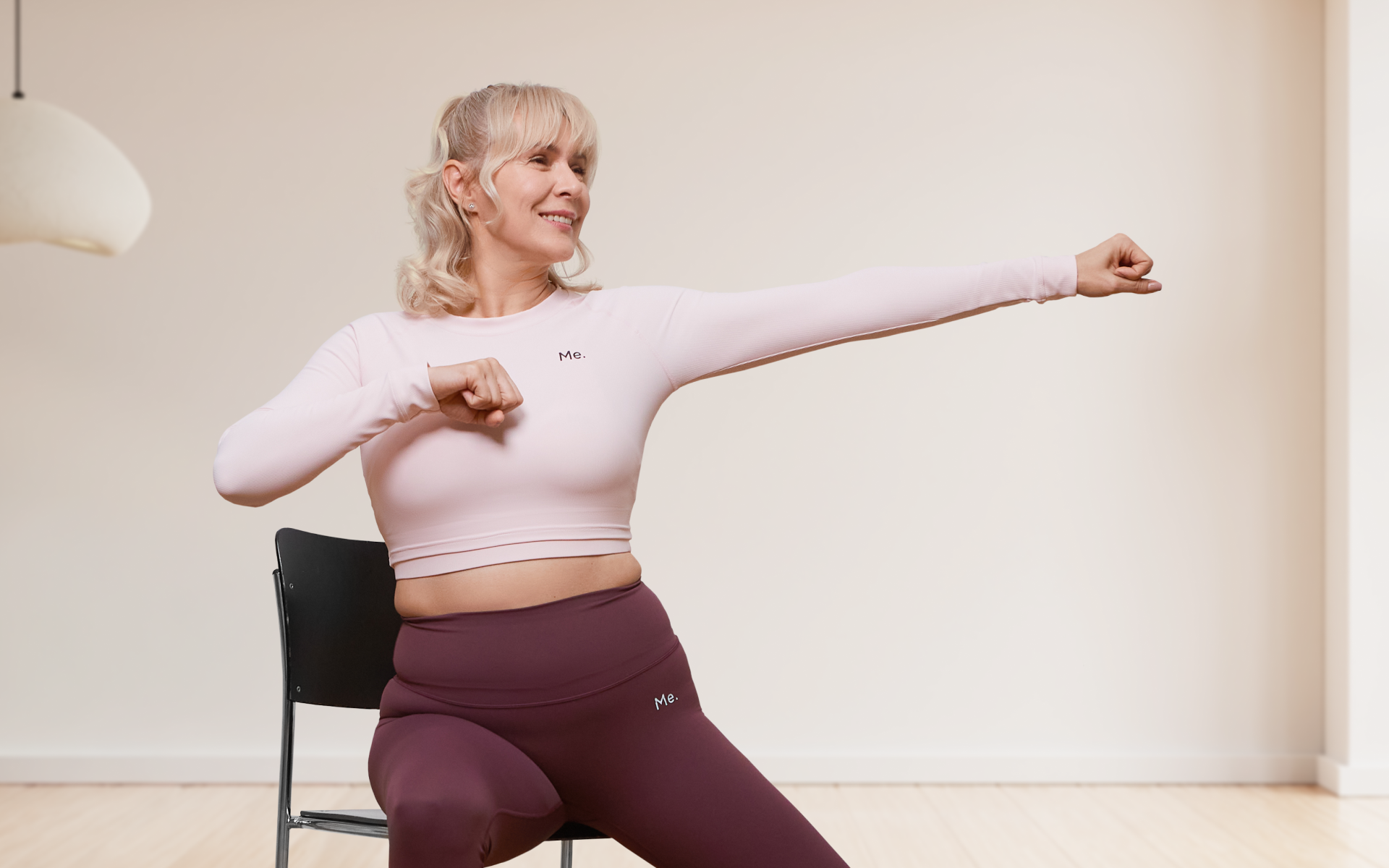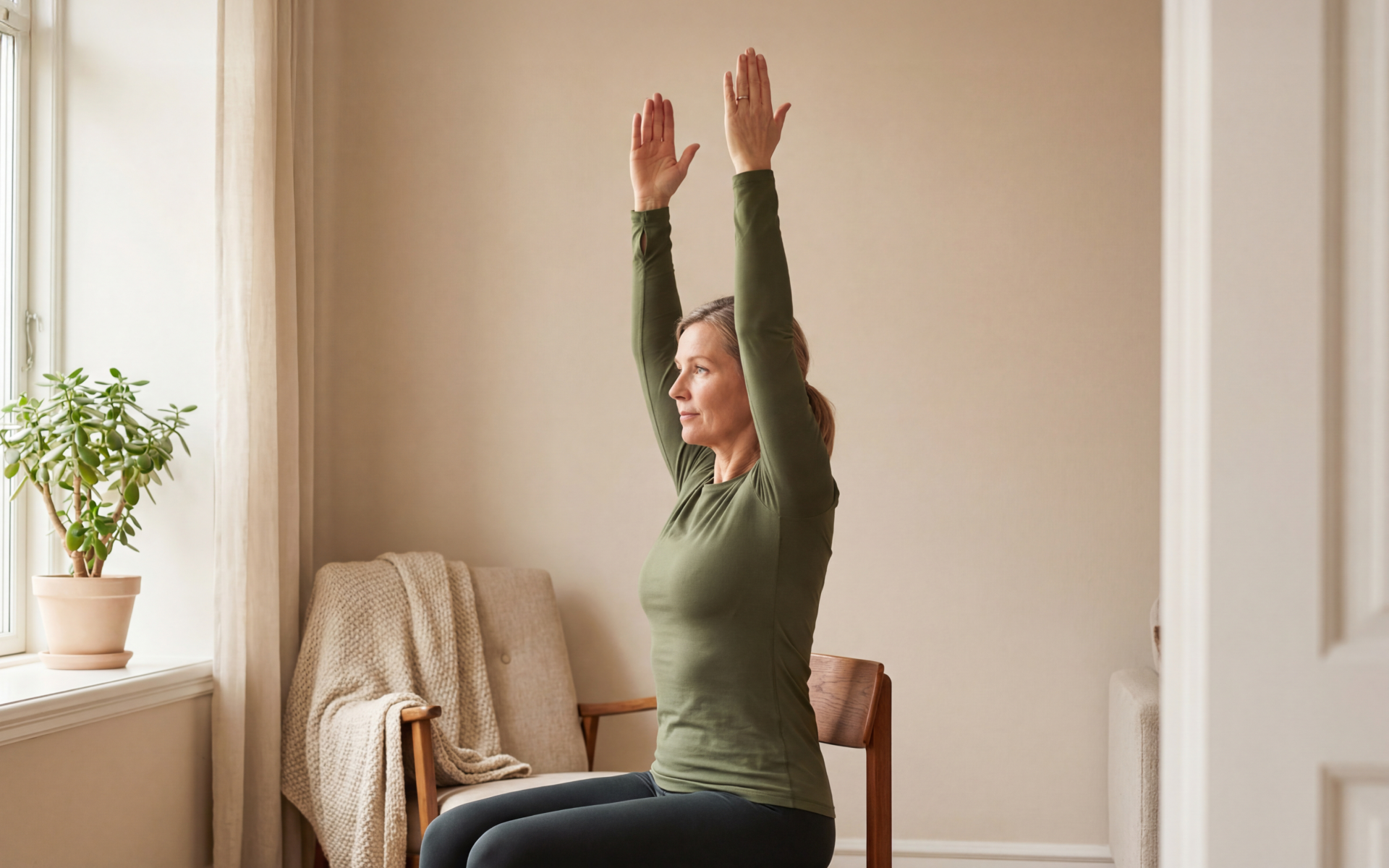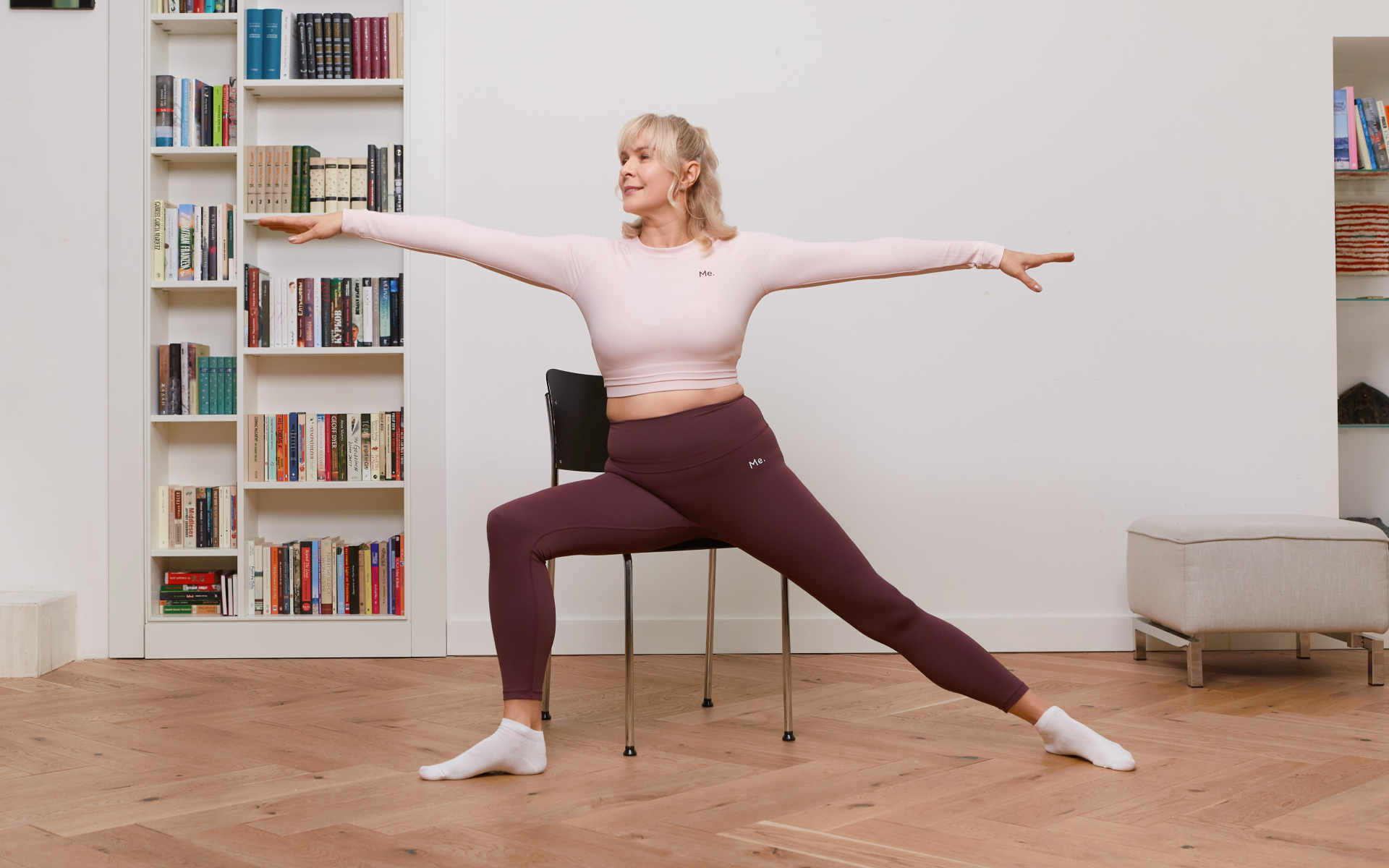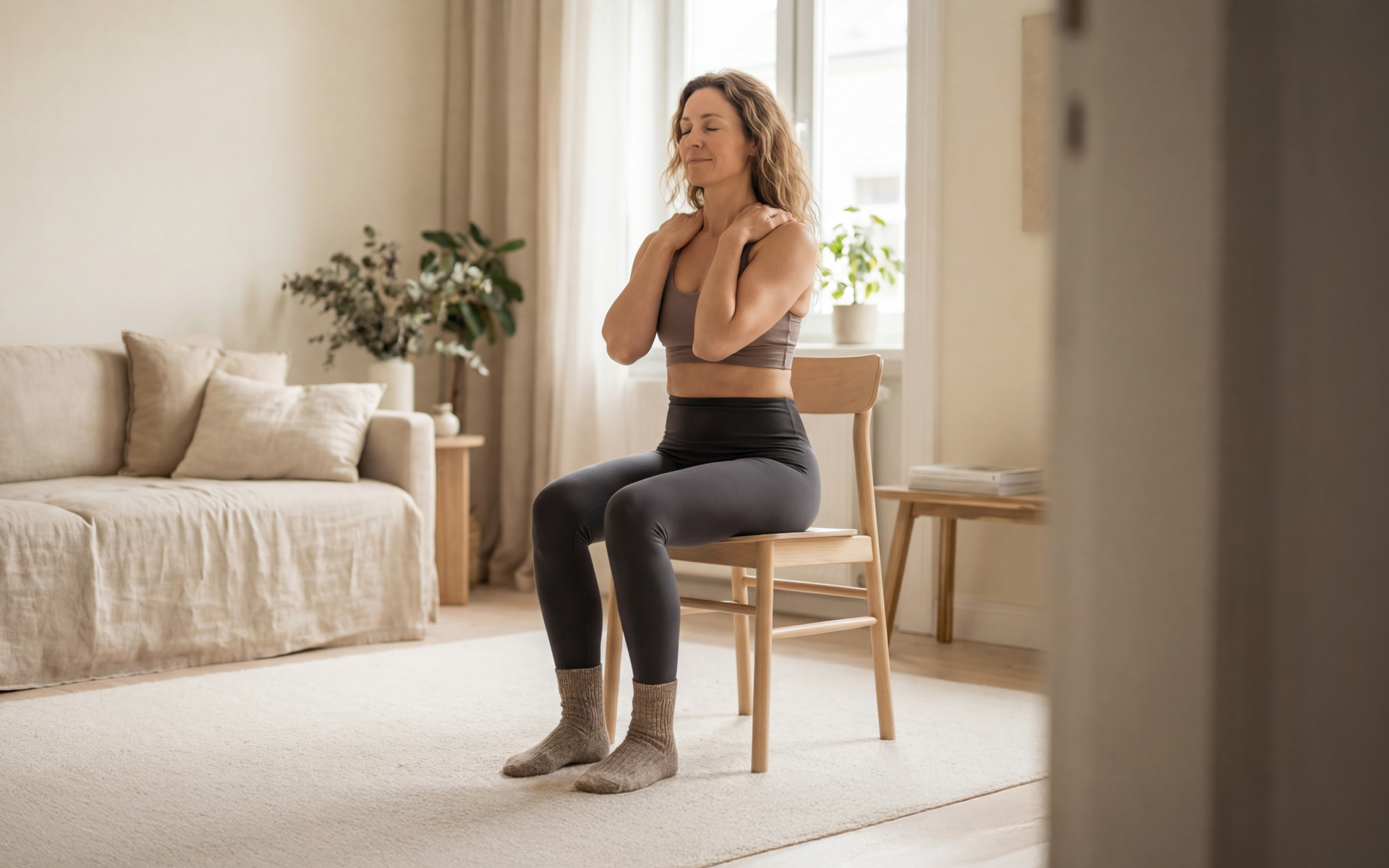Age is just a number and it shouldn’t stop you from staying active and healthy. Many seniors may dread going to the gym or working out for a variety of reasons, such as joint pain, lack of energy, or fear of injury.
However, staying active can significantly improve your overall well-being. This is particularly true as you age, because regular exercise can help maintain muscle strength and joint mobility, improve balance and coordination, and prevent chronic diseases.
Here’s a full chair workout that targets each muscle group and can easily be done at home. All you need is a sturdy chair and some motivation to get moving.
What Is the Best Chair Exercise Program for Seniors?
The best chair exercise program for seniors should include a diverse range of exercises that target various muscle groups. By engaging the arms, legs, core, and back, the routine effectively strengthens all major muscle groups. This variety promotes muscle balance and functional strength while also helping prevent boredom from repetitive exercises.
When designing a chair exercise program, you should choose safe, low-impact exercises that meet the unique needs of seniors. These exercises should be gentle on the joints while still offering a good workout. Include options that can be modified to suit different fitness levels and any physical limitations participants may have.
Consult a physician before you start any new exercise program, especially if you have any preexisting medical conditions.
Here are some tips to keep in mind while performing this chair workout:
- Use a sturdy chair: Make sure the chair you’re using is stable and has armrests for support.
- Wear comfortable clothing and shoes: Loose, breathable fabrics and supportive footwear will help you move comfortably and safely during your workout.
- Start slow and listen to your body: Ease into any new exercise routine, especially as a senior. If an exercise feels too challenging or causes pain, modify or skip it.
- Maintain proper form during the workout: Proper form prevents injury and maximizes the benefits of each exercise. Pay attention to your posture, breathing, and movement patterns throughout the routine.
8 Full-Body Chair Workout Exercises for Seniors
This comprehensive full chair workout includes a variety of exercises that engage every major muscle group, which will ensure a balanced and effective session.
Each exercise is designed to be easily modified, making it suitable for individuals at different fitness levels, whether you’re a beginner or are looking to challenge yourself.
With options for adjustments, you can customize the intensity to meet your personal fitness goals while exercising safely.
1. Seated Rowing
The seated rowing exercise primarily targets the muscles in the back, shoulders, and arms. By mimicking the motion of rowing, this exercise engages the latissimus dorsi, rhomboids, and trapezius muscles, enhancing upper-body strength and promoting better posture.
This movement is beneficial for seniors, as it helps improve strength in daily activities that involve pulling or lifting, while also promoting flexibility in the shoulders.
Steps to Do the Exercise
- Sit up straight in a sturdy chair with your feet flat on the ground and shoulder-width apart.
- Extend your arms in front of you, palms facing each other, as if holding a rowing oar.
- Engage your core by pulling your belly button toward your spine.
- Pull your arms back toward your torso, squeezing your shoulder blades together at the end of the movement.
- Hold the position for a moment, then slowly return to the starting position.
- Complete 8-12 repetitions, maintaining controlled motions throughout.
The BetterMe: Health Coaching app will provide you with a host of fat-frying fitness routines that’ll scare the extra pounds away and turn your body into a masterpiece! Get your life moving in the right direction with BetterMe!
2. Chair Side Bends
Chair side bends effectively target the obliques and lower-back muscles, contributing to improved core strength and stability.
This exercise helps seniors enhance flexibility and balance, which are essential for daily movements and preventing falls. Strengthening the side abdominal muscles can also alleviate tension in the back and improve posture.
Steps to Do the Exercise
- Sit comfortably in a sturdy chair with your back straight and feet flat on the ground.
- Place your left hand on the side of your chair for support.
- Raise your right arm overhead, with your palm facing inward.
- Lean your upper body to the left, feeling the stretch on the right side of your body.
- Hold the stretch for a few seconds, then return to the upright position.
- Switch to the other side and complete 6-10 repetitions on either side.
3. Heel Raises
Heel raises are a fantastic exercise for strengthening the calves and improving balance. This movement engages the gastrocnemius and soleus muscles in the lower legs, which are essential for daily activities such as walking, climbing stairs, and standing up. Regularly practicing this exercise can help maintain mobility and prevent falls among seniors.
Steps to Do the Exercise
- Sit up straight in a sturdy chair with your feet flat on the ground.
- Position your feet hip-width apart, ensuring stability.
- Slowly rise onto your toes, lifting your heels off the ground.
- Hold the elevated position for a moment to engage your calf muscles.
- Lower your heels back down to the ground in a controlled manner.
- Complete 10-15 repetitions, focusing on maintaining balance throughout the movement.
4. Hamstring Stretch
The hamstring stretch is important for improving flexibility in the back of the thighs and maintaining overall leg mobility. Stretching the hamstrings can relieve tension, promote better posture, and reduce the risk of injury during daily activities. For seniors, improved hamstring flexibility can help with movements such as bending down or standing from a seated position.
Steps to Do the Exercise
- While sitting in a sturdy chair, extend one leg straight out in front of you with your heel on the ground and toes pointing up.
- Keep the opposite foot flat on the floor for support.
- Slowly lean forward from your hips, keeping your back straight, until you feel a gentle stretch in the back of the extended leg.
- Hold the stretch for 15-30 seconds, then return to the starting position.
- Switch legs and repeat the stretch, completing 2-3 repetitions on each side.
Read more: 7 Chair Yoga Mobility Exercises for Seniors
5. Gentle Overhead Arm Lift
The gentle overhead arm lift exercise helps strengthen the shoulders and improve upper-body flexibility. It also promotes good posture while encouraging a sense of relaxation and coordination. This exercise is particularly beneficial for seniors who are looking to enhance their range of motion with a decreased likelihood of straining their bodies.
Steps to Do the Exercise
- Sit up straight in your chair with your feet flat on the ground and shoulder-width apart.
- Place your hands on your thighs initially for stability.
- Take a deep breath, then raise your arms overhead with your palms facing each other, stretching gently as you inhale.
- Hold the position for a few seconds while engaging your core for support.
- As you exhale, lower your arms back to your thighs.
- Repeat this process for 5-10 repetitions, moving at a comfortable pace.
6. Chest Stretch
The chest stretch is essential for opening up the chest and shoulders, counteracting the rounding that can occur from prolonged sitting or slouching. This exercise helps improve flexibility in the chest area, which can help with better posture and breathing.
Steps to Do the Exercise
- Sit tall in a sturdy chair with your feet flat on the floor and your hands resting on your thighs.
- Slowly bring your arms behind you and clasp your hands together if possible, or simply extend your arms back.
- Open your chest by drawing your shoulder blades together and pushing your arms back gently.
- Hold the stretch for 15-30 seconds, breathing deeply and feeling the expansion in your chest.
- Slowly release and return to the starting position.
- Complete this stretch 2-3 times, ensuring a comfortable range of motion.
7. Seated Leg Marches
Leg marches are a simple yet effective exercise that works the hip flexors, quadriceps, and core muscles. This movement mimics the natural motion of walking, helping improve coordination and flexibility while also promoting balance. For seniors, integrating leg marches into their routine can enhance stability and overall mobility.
Steps to Do the Exercise
- Sit up straight in a sturdy chair with your feet flat on the ground.
- Engage your core muscles for support.
- Lift your right knee toward your chest and hold for a moment.
- Lower your right leg back down.
- Repeat the movement with your left knee.
- Alternate legs aiming for 10-15 repetitions on each side, keeping a steady rhythm.
8. Single-Leg Stand
The single-leg stand is an excellent exercise for improving balance and stability, which are particularly important for seniors. It engages the core muscles and can strengthen the muscles around the ankles and knees, helping enhance functional movement and reducing the risk of falls.
In addition, practicing this exercise can promote confidence in maintaining balance during daily activities.
Steps to Do the Exercise
- Start by standing tall next to a sturdy chair or countertop for support.
- Shift your weight onto your right foot and lift your left foot off the ground slightly, bending your knee.
- Hold this position for 10-15 seconds, focusing on maintaining your balance.
- If comfortable, try raising your arms to the sides for an added challenge, but return them to the chair if needed.
- Slowly lower your left foot back to the ground.
- Repeat on the other side, completing 2-3 repetitions on each leg.
- As you gain confidence, aim to increase the duration of the stand.
The Chair Yoga Push-Up is also a great addition to these exercises.
What Is the Best Time of Day for Seniors to Exercise?
There is no one-size-fits-all answer to this question, as the best time of day for seniors to exercise can vary depending on individual preferences, schedules, and physical abilities.
Some older adults may prefer to exercise in the morning, as it can help energize and prepare them for the day, while others may find exercising in the afternoon or evening more conducive to their lifestyle.
However, there are some general guidelines seniors should keep in mind when choosing a time of day to exercise:
- Avoid strenuous activity late at night, as it can interfere with sleep patterns.
- Consider any medication schedules that need to be taken into account before or after physical activity.
- Choose a time when energy levels are typically higher and avoid exercising on an empty stomach to prevent dizziness or fatigue.
- Listen to your body and adjust your exercise routine accordingly. If you feel more energized in the morning, make that your primary workout time. If you prefer a more relaxed pace in the afternoon or evening, schedule your exercises for that time.
Ultimately, the best time of day for seniors to exercise is whenever they feel most comfortable and motivated to do so. Find a consistent routine and stick with it to reap the numerous benefits of regular physical activity.
BetterMe is your fast-track ticket to long-lasting weight loss! Tailor your fitness journey and maximize your results with just a couple of swipes!
How Often Should I Do the Full Chair Workout for Seniors?
The Centers for Disease Control and Prevention (CDC) recommends that seniors engage in at least 150 minutes of moderate-intensity aerobic activity per week, along with muscle-strengthening activities on two or more days (1).
This can be broken down into 30 minutes of exercise five days a week or shorter intervals throughout the day, as long as they add up to 150 minutes.
With that in mind, it’s recommended for seniors to incorporate this full chair workout into their routine at least three times a week, ideally every other day. This will provide enough time for the muscles to recover while still maintaining consistency and progress in overall physical fitness.
Do Chair Workouts Really Work?
Chair workouts can be incredibly effective for seniors, as they are low-impact and don’t put too much stress on the joints and muscles. These exercises can allow older adults to remain active and engaged in physical activity while also reducing the risk of injury. This could also make them ideal for those with limited mobility or those who are recovering from injuries.
Consistently doing chair workouts will:
- Improve overall strength and endurance: Regular exercise can help strengthen muscles and improve balance, making it easier to perform daily activities (2).
- Improve flexibility and range of motion: Chair exercises that involve stretching can increase flexibility and mobility in joints, reducing stiffness and pain (2).
- Boost heart health: As seniors age, it becomes increasingly important to maintain cardiovascular health. Chair workouts that involve aerobic activity can help keep the heart healthy and reduce the risk of chronic diseases such as heart disease, stroke, and diabetes (2).
- Promote mental well-being: Exercise has been shown to release endorphins in the brain, which can improve mood and reduce feelings of stress or anxiety. In addition, staying physically active can boost cognitive function and prevent memory loss in older adults (3).
- Improve balance and coordination: Chair exercises that focus on balance and coordination can help prevent falls and injuries, which are common concerns for seniors. These exercises can also improve posture and reduce the risk of back pain (2).
Read more: Chair Yoga for Muscle Building: Beginners Guide
Seniors, including those who are 70 years old, are generally encouraged to engage in physical activity at least three to five days a week (1). This frequency allows for a balance between maintaining strength and endurance while providing adequate rest days for muscle recovery. As always, it’s important to listen to your body and adjust your routine based on personal energy levels and overall health. Find low-impact yoga poses in our Easy Chair Yoga Poses article. In our opinion, one of the best exercises to improve balance in seniors is the single-leg stand. This simple yet effective exercise involves standing on one leg while holding onto a sturdy surface for support if needed. It helps strengthen the muscles that are required for balance and can be modified based on individual fitness levels. Incorporating this exercise into daily routines can significantly enhance stability over time. The most beneficial exercise for seniors is a combination of strength training and aerobic activity. This can include a number of exercises, such as chair workouts, walking, or swimming, as they promote overall fitness, strength, and cardiovascular health. It’s essential to include activities that the individual enjoys to ensure consistency and engagement in their exercise routine. In order to flatten your stomach over time, you’ll need to eat the appropriate amount of calories for your body and your current fitness levels. Flattening the stomach or reducing body fat is a long process and takes time. However, if you’re hoping to flatten your stomach in order to improve your posture while seated in a chair, this involves engaging your core muscles through seated abdominal contractions. To do this, sit up straight and draw your belly button toward your spine. Hold this contraction for a few seconds and then release. Repeat this for several sets throughout the day. In addition, incorporating chair exercises that target the oblique muscles, such as seated twists, can further help achieve a flatter stomach. Our Chair Yoga Belly Fat has more information on this.FAQs
How many days a week should a 70-year-old exercise?
What is the number 1 exercise to increase balance in seniors?
What is the most beneficial exercise for seniors?
How can I flatten my stomach sitting in a chair?
The Bottom Line
Adding a full chair workout into a senior’s fitness routine not only enhances physical strength and endurance, it also contributes to mental well-being and improved quality of life. By targeting each muscle group through these accessible exercises, seniors can maintain their independence and vitality as they age.
Ultimately, embracing a consistent workout regimen will foster a sense of accomplishment and empowerment, enabling older adults to enjoy an active lifestyle while safeguarding their health. Remember, every small effort counts, and it’s never too late to start your fitness journey.
DISCLAIMER:
This article is intended for general informational purposes only and does not serve to address individual circumstances. It is not a substitute for professional advice or help and should not be relied on for making any kind of decision-making. Any action taken as a direct or indirect result of the information in this article is entirely at your own risk and is your sole responsibility.
BetterMe, its content staff, and its medical advisors accept no responsibility for inaccuracies, errors, misstatements, inconsistencies, or omissions and specifically disclaim any liability, loss or risk, personal, professional or otherwise, which may be incurred as a consequence, directly or indirectly, of the use and/or application of any content.
You should always seek the advice of your physician or other qualified health provider with any questions you may have regarding a medical condition or your specific situation. Never disregard professional medical advice or delay seeking it because of BetterMe content. If you suspect or think you may have a medical emergency, call your doctor.
SOURCES:
- Older Adult Activity: An Overview (2023,cdc.gov)
- The Effect of Chair-Based Exercise on Physical Function in Older Adults: A Systematic Review and Meta-Analysis (2021,nih,gov)
- Physical Fitness, Mental Health, Older Adults, and Women’s Health (2024,nih.gov)










